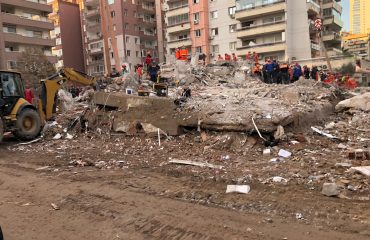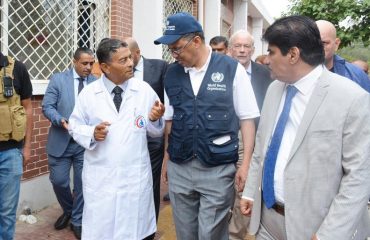

The Marmara Sea, with an area of 11,000 square kilometers, is an important inland sea for the Middle East. Connected to both the Black Sea and the Aegean Sea with the straits opened with the increase in global temperatures after the Last Glacial Maximum experienced twenty-two thousand years ago, it is considered a unique ecosystem because it is the place where the water quality characteristics of two different seas are mixed.
Nowadays, many foreign media outlets, from The Guardian to the Washington Post, draw attention to global warming with the sea snot seen in the Marmara Sea. The source of the problem is the increase in phytoplankton due to nitrogen and phosphorus wastes in the sea that has become an oxygen-poor ecosystem. The Marmara Sea is an inland sea that is exposed to the domestic wastes of almost 20 million of the Marmara region population. At the same time, it attracts the waste burden of our industrially developed provinces such as Istanbul, Bursa and Kocaeli. The carbon-rich wastes of the petrochemical industry in Kocaeli are undoubtedly damaging the Marmara Sea. In addition, the tanker traffic of the straits should not be ignored. Marmara is the only transit route for tankers crossing to and coming from the Black Sea. The number of tankers over 200 meters using the Marmara Sea in a year is almost 10,000. The pollution created by the wastes of these tankers has become the sea drop by drop along with other wastes.
Can Kanal Istanbul kill the Marmara Sea?
Of course, another issue we should not forget is ecological factors. The seawater of the Black Sea, which has high nutritional value, has been feeding the Marmara for the last 10.000 years. The increase in this amount of water will also bring an extra burden to Marmara. For this reason, I would like to remind the question of how necessary Kanal Istanbul, a government project to connect the Black Sea and the Marmara Sea via an artificial canal, is. My answer is a very clear “no”.
Main problem is failing to learn from the past…
We have experienced the same problems that we are experiencing today in the past. For example, a similar situation occurred in the Marmara Sea in 2007. Forgotten!… Similar situations occurred in the world’s seas due to petrochemical wastes and became news. For example, oil pollution from tankers in the Gulf of Mexico in 2010 caused sea snot. During this period, marine scientists wrote that the balance between carbon, nitrogen, and phosphorus would result in mucus-like substances in the seas.
So what is the solution to the problem?
Pollution in the Marmara Sea cannot be defined as an acute situation. It is a situation that manifests itself step by step and gains continuity due to the increase in human population growth and industrialization activities around the Marmara Sea. The news that the pollution has reached dangerous levels has recently been announced in the local press. For example, the red algae that hit the Caddebostan coast of Istanbul on 25 December 2020 was one of the pollution indicators in the Marmara Sea. At the same time, aerial photographs of Zeytinburnu clearly revealed the pollution in the Marmara Sea.
Yes, what are the solutions at this point?
It does not seem possible to find a solution in the short term to this problem, which develops gradually and becomes chronic. However, it is of course possible to produce solutions for the future in the medium and long term.
1- Local governments of the settlements around the Sea of Marmara should urgently prepare and put into effect action plans.
Strict measures regarding waste management should be taken in order to create a sustainable environment around the Marmara Sea in the near future. Domestic and industrial wastes in Kocaeli and Bursa, especially in Istanbul with a population of 16 million, should be treated biologically and then discharged. All local governments on the coast of Marmara should work together on this issue.
2- Fresh water resources in the Marmara Region carry pollutants to the sea.
It is not only the wastes left to the sea that cause the Marmara Sea to become depleted of oxygen. Pollution in the Ergene and Susurluk rivers in the Marmara Region threatens the sea. This is a problem we have had for years. It is one of the issues that the Ministry of Environment needs to take urgent action.
3- Hunting pressure causes an increase in the number of phytoplankton.
The fishing pressure created by the ongoing fisheries in the Marmara Sea causes the fish populations, which are the predators of phytoplankton, to decrease. This burden brought by the pressure of hunting together with pollution causes the sea to deoxygenate due to the increase in invertebrates. Measures to reduce fishing pressure will relieve Marmara in the medium and long term.
4- Kanal Istanbul will increase the burden created by the Black Sea on the Marmara Sea.
Kanal Istanbul will cause the nutrient-rich water of the Black Sea to enter the Marmara, thereby disrupting the ecological balance that has been established for thousands of years. In addition, tanker and ship traffic in the Marmara Sea will follow a different course. The result is further pollution of the Marmara Sea. It is inevitable for managers to think over and over again about the necessity of this project.
5- Global warming increases sea water temperature.
Average sea water temperatures have increased by 1.3 degrees Celsius in the last 100 years. Now, Turkey should seriously consider the Paris Climate Agreement and explain its roadmap on climate change.
The Marmara Sea is a unique ecosystem not only for our country but also for the world. We have to preserve it, keep it alive and pass it on to future generations. The time to take concrete steps seems long past; but wherever we turn from the loss, it is profit.


